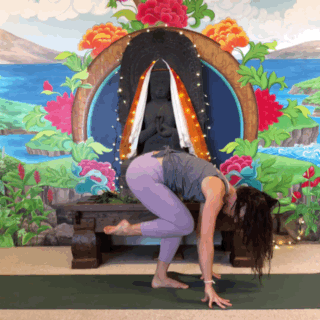Module 5 • Rediscovering the Back Line of our Body and Awareness: From Physical Endurance to Spiritual Emergence
Lesson 1
Textbook Title: HARMONY OF THE BACK LINE: AWAKENING, INTEGRATION, AND THE POWER OF ECCENTRIC TONE
Overview: Eccentric tone in the back line supports integrated, functional movement and prevents common imbalances. Practicing with this awareness creates a bridge to Turya Consciousness, where inner surrender allows deeper presence to naturally emerge.
Exercises Covered: Single Leg Bridge, Swimming Shalabhasaana
Length of Video: 58 min.
Lesson 2
Textbook Title: EMPTYING OUR CUPS: HIP EXTENSION MOVEMENTS, POSTURES & EXERCISES
Overview: Engaging the posterior chain—particularly the glutes, hamstrings, and back body—creates balanced hip extension, helping to release tight hip flexors and correct common postural issues like anterior pelvic tilt.
Exercises Covered: Workshop: Engaging our Hamstrings, Workshop: Spinal roll up progression to reunite the back line team, Virabhadrasana 3 - Eccentric Work with Flexion, Standing splits, Ardha Hanumanasana
Length of Video: 1 Hr. 28 min
Exercises Covered in Class & Homework Assignment:
Exercises Covered in Class:
Coming Soon
Homework:
For your homework assignment, start weaving the exercises and postures you've learned in class into your daily personal yoga routine. When relevant, extend your practice beyond the confines of the mat into everyday life. Pay attention to what is motivating your practice, what is speaking to you, and channel that inspiratoin into developing a yoga sequence aimed at the students you regularly teach, rather than just the attendees of this training. From this personalized sequence, choose an 8-minute segment to present to our training class for valuable feedback. Additionally, prepare a concise 1-2 minute introduction that summarizes what has inspired you this week, which you can share as a preamble to your sequence. While it's an added bonus, not a requirement, consider infusing that underlying theme into your teaching cues to enrich the overall class experience.
Workshop: Engaging our Hamstrings
Spinal Roll Up Workshop
Spinal Rolling: Benefits, Cautions, and Spinal Health Considerations: Rolling up the spine is a natural and therapeutic movement that traces its roots to our earliest stages of mobility as humans. Here's why:
Benefits of Spinal Rolling:
Flexibility and Mobility: The action of rolling articulates each vertebra, encouraging flexibility and improving the range of motion in the spine.
Muscular Engagement: It activates the muscles surrounding the spine, including the core, enhancing postural support and strength.
Circulation and Fluidity: The gentle compression and release as you roll can promote better circulation of spinal fluids, potentially aiding in nutrient exchange and toxin removal.
Relaxation and Stress Relief: Rolling motions can stimulate the parasympathetic nervous system, which can help in relaxation and stress reduction.
Cautionary Note for Those with Spinal Issues: While spinal rolling offers numerous benefits to many, it may not be suitable for everyone. Individuals with existing spinal conditions or complications, such as disc herniations, osteoporosis, recent surgeries, or other related issues, should approach this movement with caution. Rolling can exert pressure on affected areas, potentially leading to exacerbation of symptoms or further injury. It's essential for those with spinal problems to consult with a healthcare or therapeutic professional before incorporating such movements into their routines. Always prioritize safety and well-being.
Hasta Padangustasana





